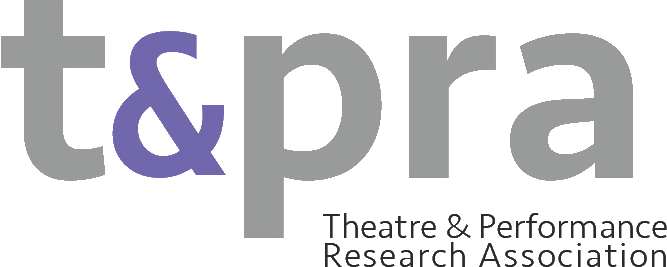Bodies and Performance 2019
Full Name: Dr Sarah Crews
Annual Conference Theme (if applicable): Feeling Bad: Negative Affects, Performance and Bodies.
What were the main points that emerged from your WG this year?
The first session opened with a welcome and some housekeeping notes from Claire Hampton and Victor Ladron De Guevara. Key to this introduction was the invitation for group members to take time to make eye contact with everyone in the room. I can only speak for myself but the time taken to engage purposefully and meaningfully with everyone in the room seemed to situate participants in their bodies and thus noticing and responding to more than just what one might be thinking or saying. It created a different feeling in the room and was successful in introducing individuals to one another in a way that transcends the scholarly performance of reciting one’s name, position and affiliation with any given institutions. We followed this exercise up with a more traditional rollcall of who is in the room, and I felt that the previous exercise allowed for the people in the room to be more vulnerable and open in their introductions (if they wanted to). For example, some individuals had recently left their institutions through difficult circumstances, which caused us to reflect on whether we actually need to hear where presenters are from – perhaps their names and ideas are more interesting/important than their affiliation with an institution or department? This led to a more hospitable environment, which was in keeping with the themes of our first two papers.
Session 1 – Shame, Fragility and Resistance: Bodies that feel bad. Lynne McCarthy began the working group activities with her paper Speaking of IMELDA and the performance of hostility/hospitality in Ireland’s abortion tourism. This provoked questions of access, accessibility, refuge and activism, which was very much a prelude to Royona Mitra’s and Simon Ellis’s exploration of the construction of white bodies that both wield power and ‘feel bad’ in the UK’s contemporary dance industry in their paper. Both ‘Dancing White Fragility’ and ‘Speaking in IMELDA’ gave rise to what it means to be or feel welcome.
Discussion: This session, and indeed the content of the paper’s, allowed for more time to explicitly set the tone of the working group for the next three days. Following the invitation of ‘Radical Kindness’ from Roberta Mock in the opening session, Claire Hampton, Victor Ladron De Guevara and Jennifer Parker-Starbuck, encouraged participants to discuss thoughts and responses with one another, rather than jumping straight in to respond or ask questions directly to the speaker. This was seemingly very successful as it allowed for thoughtful responses and discussions to emerge and continue over the course of the few days. It also meant that group members got used to addressing one another by name as they got to know each other through discussions after each paper. Questions of environments, etiquette and behaviours were key to both of these papers – each gave rise to binaries of hospitality and hostility in institutions and everyday life. The subjects of care and responsibility in response to this binary seemed to permeate the discussions within the following 3 days. This session was attended by roughly 30 participants – a combination of new and familiar faces to the group.
Session 2: Protrusion, Exclusions and Intrusions: Irritation as Potentiality
The panel began with Savannah Whaley’s paper ‘Communities of (Bad) Feeling: Exclusion and Emotion in Howardena Pindell’s Free, White and 21 and Nicola L.’s Le Manteau Pour Onze Personnes (Same Skin for everybody). The paper explored Howardena Pindell’s Free, White and 21 (1980) and her involvement with PESTS, an activist. It brought up questions of abnormal/negative feelings and emotions, which connected well with the second paper from Eirini Kartsaki on how ‘protrusions in contemporary art and performance appear in different forms’. The key themes across both of these papers were fragmentation, bodily shapes, abstract shapes/bodies in performance and the tensions between being a body and having a body. Key connections throughout the panel that sparked conversation were rooted in notions of power, choice and decision making. To what extent are we conscious of our own desires and how they are formed and enacted? This question was rooted in the third presentation from Alissa Clarke. ‘A Hole in the Head and the Heart: Artistic encounters across arousal and repulsion’ unpacked the difficult and contentious works of Amanda Feilding and feminist sex positive multimedia artist, Penny Slinger. The session concluded with a lively discussion on desire, ambivalence, excess and alternative ways of being in the world. This session was attended by roughly 28 people.
The Open Panel: (Dis) Embodied Technologies was a joint session with Science and Performance and included the following presentations: Jennifer Parker-Starbuck on ‘Feeling Resistant: Embodiment, VR Environments and the Trigger Finger’; Adelina Ong on ‘Resisting Neoliberal Technologies of Self-repair: Performing Depression, Teaching a Mental Wellbeing’; and Alexander Kelly on ‘Living A Lunar DayIt’. Again these papers gave rise to questions of care and responsibility – particularly when linked with notions of self-care, labour and productivity in Capital culture. Time and temporality, as well as embodiment were also key features within the papers. As Jennifer Parker Starbuck notes ‘The rise of VR, Mixed-Reality and 360-degree storytelling in performance contexts necessitates new modes of embodied storytelling, and practitioners have argued for a rethinking of empathy, of immersion’. Perhaps this could be a central theme to explore in the next conference/event, as it draws links with several other working groups, notably Performer Training, Performance and New Technologies and Performance and Science. This session was extremely popular and resulted in individuals sitting around different parts of the room on the floor as we ran out of chairs. There were roughly 65 bodies in the room and all stayed for the full duration of the panel. Session 3: Inscriptions, Affects and Eco-Systems: Bodies that Try We began with Sarah Hopfinger’s presentation entitled ‘Performance and Chronic Pain: Ecologies of Pain’. Through creative practice and presentation Sarah explored the connections between her own personal experiences of chronic pain and the concept of pain felt globally/environmentally. Sarah’s contribution was followed by Sara Reimers’s presentation ‘Making an Appearance: Exploring the Emotional Labour of Aesthetic Labour’. Due to time running constraints as a result of the later starts after lunch, we had only time for 2 questions before turning to our concluding paper. Paul Geary’s ‘Performing Offence: Indignity and Provocation in Ivo Dimchev’s P-Project’ evoked interesting questions on the ethical role of the scholar in works such as Dimchev’s P-Project. This session had a slightly smaller audience of around 25 participants. A key theme raised in Sarah Hopfinger’s paper that was arguably not attended fully, was how bodies connect with, respond to our broader environments. How might we reach out? Our fourth and final session Feeling Good: Bodily Fluids and Sexual Acts opened with Phoebe Patey-Ferguson’s ‘Pissing on/off the Rich: the Transgender Terrorist Performances of Rose Wood’; and was followed by Poppy Corbett’s exploration of Kim Noble’s work entitled ‘Revolting sweat, shit and semen: Politicisation of negative affects and abjects in Kim Noble’s performance piece You’re Not Alone’. The final panel ran to time and concluded by a very illustrative reminder of the differences between ‘being a body’ and ‘having a body’ in Karen Abadie’s ‘Performing the unspeakable on the skin’. Each presenter had time for questions and responses as part of a joint Q&A at the end of the panel, and this led into a discussion of the key themes and ideas that have spanned all sessions, as well as possibilities for the next event and conference. The space was occupied by roughly 25 participants and we spoke at length about the precarious political context we’re facing at the moment, both as scholars and as bodies in a fraught, complicated world.
What was discussed at your business meeting?
We reflected on our gut feelings (in reference to Sara Ahmed’s quote, which was cited in several of the papers) to the works encountered and our conversations over the duration of the conference and it was suggested that possible themes for further exploration may be:
- Critical Care (it was noted that ‘Care’ is also the focus of the next Psi conference, which could create space for collaboration)
- The extent to which we are conscious of and/or perform our gut responses, particularly those that are seen as being ‘negative’.
- Etiquette and the mediation of negative emotions/feelings.
- Exclusion/inclusion of particular bodies and minds. Physical invitations as well as unwanted/intrusive contact.
- Reflecting inward/outward. Reaching out.
- Access – those that are not here.
Types of contributions:
Papers and 1 performance/paper
Number of formal contributors (those listed in book of abstracts) 11
Approx. overall number of delegates who attended your WG Sessions There was an average of 28 people in each session with over 65 people present at the Open Panel session.
Composition of WG (PG, ECR, etc.)
PG, ECR, MCR and senior academics including Professors
Did you have any non-UK participants? Yes
If your WG hosted an Open Panel, do you have any feedback?
As above, this was a really popular joint session and we could have done with more space.
Any additional points or feedback not covered above?
We would like to thank our colleagues at Exeter for taking up the difficult task of organising this conference in such a short space of time. Technical support and general support were incredible throughout – especially from department technicians and student volunteers. Though it was seemingly unavoidable, the transitions between the venues meant that it was difficult to run to time, and this transition was difficult for some of our participants who were dealing with physical injury. This aside, the conference was extremely well-organised and facilitated lots of opportunity for kindness and conversation between peers.

